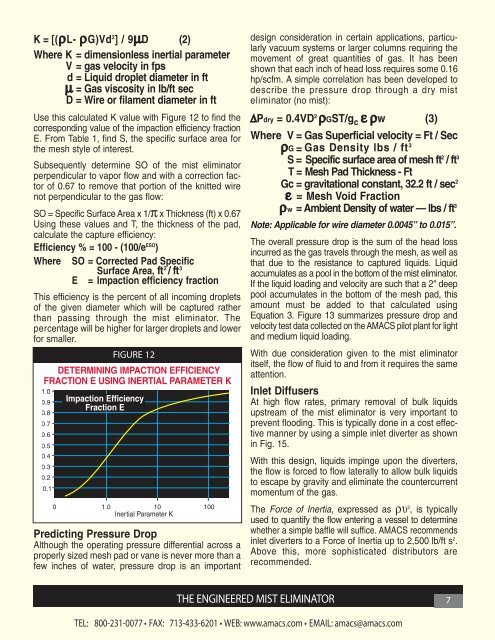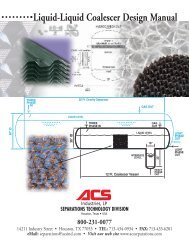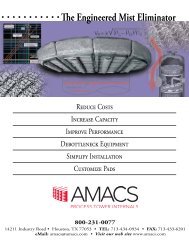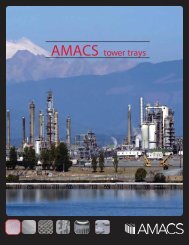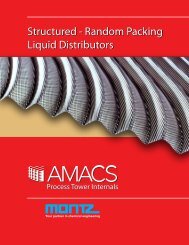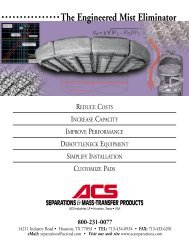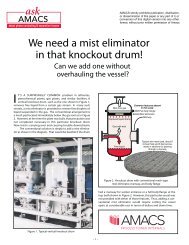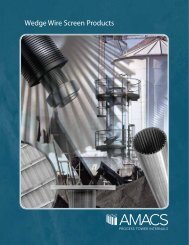Mesh and Vane Mist Eliminator Brochure - AMACS Process Tower ...
Mesh and Vane Mist Eliminator Brochure - AMACS Process Tower ...
Mesh and Vane Mist Eliminator Brochure - AMACS Process Tower ...
Create successful ePaper yourself
Turn your PDF publications into a flip-book with our unique Google optimized e-Paper software.
K = [(ρL- ρG)Vd 2 ] / 9µD (2)<br />
Where K = dimensionless inertial parameter<br />
V = gas velocity in fps<br />
d = Liquid droplet diameter in ft<br />
µ = Gas viscosity in lb/ft sec<br />
D = Wire or filament diameter in ft<br />
Use this calculated K value with Figure 12 to find the<br />
corresponding value of the impaction efficiency fraction<br />
E. From Table 1, find S, the specific surface area for<br />
the mesh style of interest.<br />
Subsequently determine SO of the mist eliminator<br />
perpendicular to vapor flow <strong>and</strong> with a correction factor<br />
of 0.67 to remove that portion of the knitted wire<br />
not perpendicular to the gas flow:<br />
SO = Specific Surface Area x 1/π x Thickness (ft) x 0.67<br />
Using these values <strong>and</strong> T, the thickness of the pad,<br />
calculate the capture efficiency:<br />
Efficiency % = 100 - (100/e ESO )<br />
Where SO = Corrected Pad Specific<br />
Surface Area, ft 2 / ft 3<br />
E = Impaction efficiency fraction<br />
This efficiency is the percent of all inco ming droplets<br />
of the given diameter which will be captured rather<br />
than passing through the mist eliminator. The<br />
percentage will be higher for larger droplets <strong>and</strong> lower<br />
for smaller.<br />
FIGURE 12<br />
DETERMINING IMPACTION EFFICIENCY<br />
FRACTION E USING INERTIAL PARAMETER K<br />
Predicting Pressure Drop<br />
Although the operating pressure differential across a<br />
properly sized mesh pad or vane is never more than a<br />
few inches of water, pressure drop is an important<br />
design consideration in certain applications, particularly<br />
vacuum systems or larger columns requiring the<br />
movement of great quantities of gas. It has been<br />
shown that each inch of head loss requires some 0.16<br />
hp/scfm. A simple correlation has been developed to<br />
describe the pressure drop through a dry mist<br />
eliminator (no mist):<br />
∆Pdry = 0.4VD 2 ρGST/g c ε ρw (3)<br />
Where V = Gas Superficial velocity = Ft / Sec<br />
ρG = Gas Density lbs / ft 3<br />
S = Specific surface area of mesh ft 2 / ft 3<br />
T = <strong>Mesh</strong> Pad Thickness - Ft<br />
Gc = gravit ational constant, 32.2 ft / sec 2<br />
ε = <strong>Mesh</strong> Void Fraction<br />
ρw = Ambient Density of water — lbs / ft 3<br />
Note: Applicable for wire diameter 0.0045” to 0.015”.<br />
The overall pressure drop is the sum of the head loss<br />
incurred as the gas travels through the mesh, as well as<br />
that due to the resistance to captured liquids. Liquid<br />
accumulates as a pool in the bottom of the mist eliminator.<br />
If the liquid loading <strong>and</strong> velocity are such that a 2" deep<br />
pool accumulates in the bottom of the mesh pad, this<br />
amount must be added to that calculated using<br />
Equation 3. Figure 13 summarizes pressure drop <strong>and</strong><br />
velocity test data collected on the <strong>AMACS</strong> pilot plant for light<br />
<strong>and</strong> medium liquid loading.<br />
With due consideration given to the mist eliminator<br />
itself, the flow of fluid to <strong>and</strong> from it requires the same<br />
attention.<br />
Inlet Diffusers<br />
At high flow rates, primary removal of bulk liquids<br />
upstream of the mist eliminator is very important to<br />
prevent flooding. This is typically done in a cost effective<br />
manner by using a simple inlet diverter as shown<br />
in Fig. 15.<br />
With this design, liquids impinge upon the diverters,<br />
the flow is forced to flow laterally to allow bulk liquids<br />
to escape by gravity <strong>and</strong> eliminate the countercurrent<br />
momentum of the gas.<br />
The Force of Inertia, expressed as ρυ 2 , is typically<br />
used to quantify the flow entering a vessel to determine<br />
whether a simple baffle will suffice. <strong>AMACS</strong> recommends<br />
inlet diverters to a Force of Inertia up to 2,500 lb/ft s 2 .<br />
Above this, more sophisticated distributors are<br />
recommended.<br />
THE ENGINEERED MIST ELIMINATOR 7<br />
TEL:<br />
800-231-0077 • FAX: 713-433-6201 • WEB: www.amacs.com • EMAIL: amacs@amacs.com


